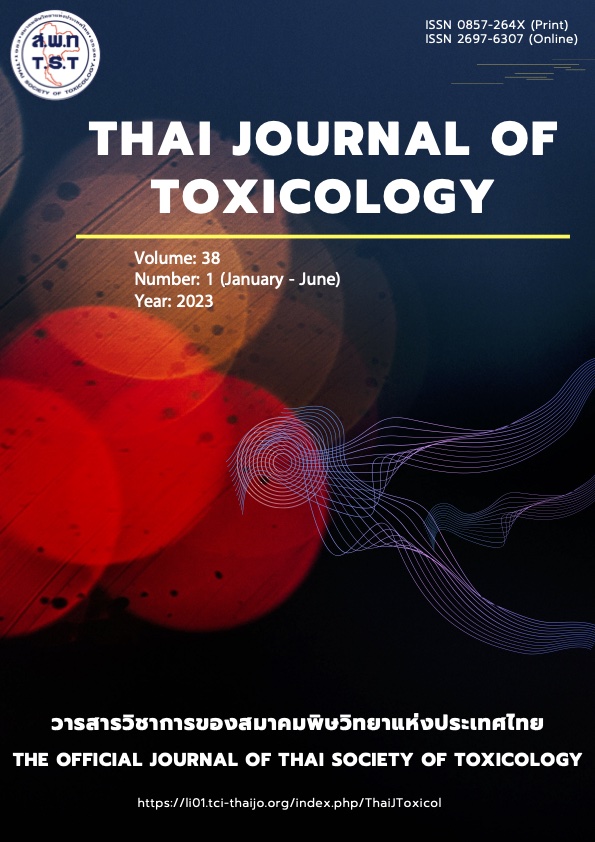The Stability of Carbamates in Blood Samples under Experimental Conditions
Main Article Content
Abstract
Carbamate insecticides are the most prevalent compounds involved in cases of poisoned patients in Thailand. However, stability data of carbamate insecticides are relatively limited in literatures. This study investigated the stability of three common carbamate insecticides including carbaryl, carbofuran and propoxur under different temperature conditions. Pooled blood samples were spiked with carbaryl, carbofuran and propoxur at three concentration levels (low, medium and high). These compounds were analyzed for initial concentrations, they were stored both at room temperature (25°C) and in a refrigerator (4°C). Next, all samples were analyzed for these compounds on the 1st, 2nd, 3rd, 7th, 14th and 30th day at 25°C and on the 3rd, 7th, 14th, 30th, 60th, 90th and 180th day at 4°C. Descriptive statistics and one-way ANOVA were performed to investigate the changing trend of three compounds. Changing rates in three analyte concentrations at 25°C were significantly decreased by less than 15% from the initial concentrations on the 7th day to the 30th day (p<0.001). At 4°C, three analytes decreased significantly by less than 15% from initial concentrations on the 7th day to the 180th day (p<0.01). Carbofuran decreased at the fastest rate, followed by propoxur and carbaryl, respectively. In conclusion, carbaryl, carbofuran and propoxur were significantly unstable at 25°C and 4°C. Carbofuran was the most unstable compound, followed by propoxur and carbaryl, respectively. This suggested that blood samples from suspected carbamate poisoning cases should be collected and analyzed as soon as possible because these ordinary carbamate insecticides were unstable at room temperature and 4°C.
Article Details
References
Wananukul W, Sriapha C, Tongpoo A, et al. Human poisoning in Thailand: The Ramathibodi Poison Center's experience (2001-2004). Clin Toxicol (Phila). 2007; 45(5): 582-8.
Tongpoo A, Sriapha C, Wongvisawakorn S, et al. Occupational carbamate poisoning in Thailand. Southeast Asian J Trop Med Public Health. 2015; 46(4): 798-804.
Eddleston M, Buckley NA, Eyer P, et al. Management of acute organophosphorus pesticide poisoning. Lancet. 2008; 371(9612): 597-607.
Albano GD, Malta G, La Spina C, et al. Toxicological Findings of Self-Poisoning Suicidal Deaths: A Systematic Review by Countries. Toxics. 2022; 10(11): 654.
Barr DB, Buckley B. In vivo biomarkers and biomonitoring in reproductive and developmental toxicity. In: Gupta RC ed. Reproductive and developmental toxicology. London: Academic Press; 2011: 253-65.
Reiser RW, Dietrich RF, Djanegara TKS, et al. Identification of a novel animal metabolite of methomyl insecticide. J Agric Food Chem. 1997; 45(6):2309-13.
Kawakami Y, Fuke C, Fukasawa M, et al. An experimental study of postmortem decomposition of methomyl in blood. Leg Med (Tokyo). 2017; 25: 36-42.
Ramagiri S, Kosanam H, Sai Prakash PK. Stability study of propoxur (Baygon) in whole blood and urine stored at varying temperature conditions. J Anal Toxicol. 2006; 30(5): 313-6.
Scientific Working Group for Forensic Toxicology. Scientific Working Group for Forensic Toxicology (SWGTOX) standard practices for method validation in forensic toxicology. J Anal Toxicol. 2013; 37(7): 452-74.
Ghosh AK, Brindisi M. Organic carbamates in drug design and medicinal chemistry. J Med Chem. 2015; 58(7): 2895-940.
van der Meer PF, de Korte D. The effect of holding times of whole blood and its components during processing on in vitro and in vivo quality. Transfus Med Rev. 2015; 29(1): 24-34.
Donaldson AE, Lamont IL. Biochemistry changes that occur after death: potential markers for determining post-mortem interval. PLoS One. 2013; 8(11):e82011.
Yamagishi Y, Iwase H, Ogra Y. Post-Mortem Changes of Methomyl in Blood with Hemoglobin. Chem Res Toxicol. 2021; 34(1): 161-8.


